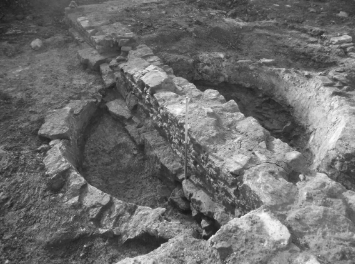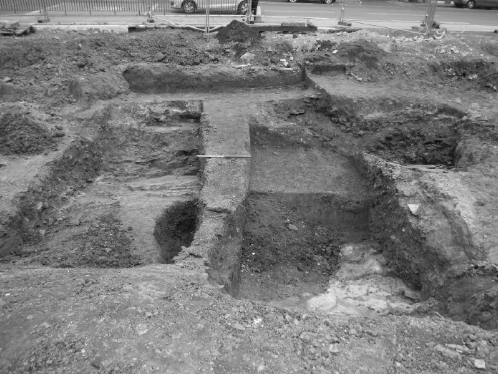Archaeological report
The excavation took place between March and April 2016 at the site of the new University of Edinburgh Bayes Centre


The Excavation
Excavation work in advance of construction works for the University of Edinburgh uncovered a stratified series of remains that illustrate the development of the Potterrow area from a marginal area on the outskirts of the medieval and early post-medieval burgh of Edinburgh to its incorporation within the growing city. These remains included a large medieval quarry site, evidence for skilled metalworking, early urban commercial and domestic structures, and the substantial remains of 19th century tenements and a school.
The excavation took place between March and April 2016 at the site of the new University of Edinburgh Data Technology Institute (now known as the Bayes Centre). During an initial watching brief, it quickly became apparent that a full archaeological excavation of the site was required. The full excavation record (Johnstone 2016a) can be found in the site archive, while individual specialist report on the artefacts and ecofacts recovered during the archaeological works can be found in archive reports to be place in the National Record of the Historic Environment (NRHE).
Structural remains were identified almost immediately below the current ground level and ultimately the archaeological works identified a rich archaeological sequence from the late medieval period onwards. This included evidence for a medieval quarry, a late medieval metalworking area, a range of post medieval structures, and large scale 19th century domestic and public buildings.
The ‘Potter Row’ name
One of the most interesting aspects of the history of the Potterrow area is the process by which it came by its name. In modern times ‘Potterrow’ is the name given to a road running between Bristo Place to the north and Buccleuch Street to the south. Historically this street was more commonly referred to as ‘the Potter Row’ a title that pre-dates any known historic maps of the area. The name suggests that it took its name from the main activity taking place there. Taken literally, this would suggest a ‘row’ or a street lined with the works of ‘potters’ and an area for the crafting of ‘pots’. However, while to the modern mind the terms ‘pots’ and ‘potters’ evoke images of ceramic working, in the late medieval period, the term ‘potter’ was a title for those who worked in copper and brass metalwork.
Excavation at the present Potterrow site has allowed an unbroken record of activity in this area to be recorded from the medieval period through to the present. This provides an insight into the development of this area of Edinburgh and also of early post-medieval Scottish metalworking practices.
Conclusion
The excavations undertaken at Potterrow DTI, and at Potterrow 2 have provided a comprehensive record of the expansion of urban activity and occupation into an area once peripheral to the burgh of Edinburgh. Activity in this early suburb of Edinburgh ranged from the working of a significant stone quarry in the late medieval period, to copper alloy working in the 16th and 17th century, to the gradual spreading of domestic and commercial settlement through the 18th century. The area was fully incorporated in the core of the growing city in the 19th century.
Perhaps the most intriguing result of these works was the clear link identified between the development of a metalworking district on the periphery of Edinburgh and the naming of both the district and the thoroughfare which crossed through it. The evidence for the casting of copper alloy in Potterrow adds significantly to the evidence for small-scale metalworking in the urban peripheries of late medieval and early post-medieval Scotland.
Acknowledgements
All of the excavation teams are thanked for their efforts: Nicholas Johnstone, Jessica Lumb, Alex Wood, Kieran Boyle and Frazer Stewart. Sam O’Leary, Diana Sproat and Jamie Humble prepared the illustrations. Advice and comments were kindly provided by Ciara Clarke, Dawn McLaren and Mike Roy. John Lawson of The City of Edinburgh Council Archaeology Service (CECAS)
This information was provided by AOC Archaeology Group in their University of Edinburgh DTI, Potterrow (Phase 3 Development), Edinburgh Archaeological Works report.

